
Forficulidae is a family of earwigs in the order Dermaptera. There are more than 70 genera and 490 described species in Forficulidae.

Forficula is a genus of earwigs in the family Forficulidae. The best known species is Forficula auricularia.
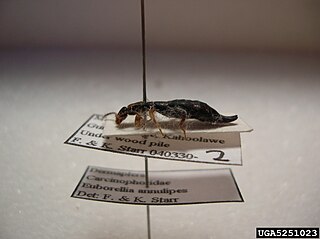
Anisolabididae is a family of earwigs, in the suborder Neodermaptera and the order Dermaptera.
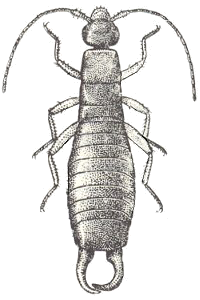
Anisolabis is a genus of mostly Asian earwigs in the subfamily Anisolabidinae. It was cited by Srivastava in Part 2 of Fauna of India. The name Anisolabis stems from the asymmetry of the male cerci; the right cercus being more acute than the left.
Antisolabis is a genus of earwigs, the sole member of the subfamily Antisolabiinae. It was cited by Srivastava in Part 2 of Fauna of India. It was also cited at an earlier date by Steinmann in his publication, The Animal Kingdom in 1986, 1989, 1990, and 1993.
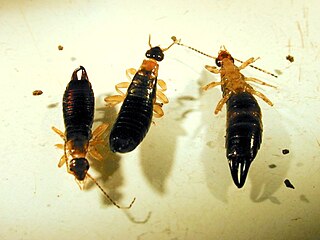
Euborellia is a genus of earwigs in the subfamily Anisolabidinae. This genus, which has a world-wide distribution, was erected by Malcolm Burr in 1909 and was cited by Srivastava in Part 2 of Fauna of India.
Flexiolabis is a genus of earwigs in the subfamily Anisolabidinae. It was cited by Steinmann in The Animal Kingdom.
Indolabis is a monotypic genus of earwigs in the subfamily Anisolabidinae. It was cited by Steinmann in The Animal Kingdom. The only species is Indolabis papua.
Neolabis is a genus of earwigs in the subfamily Anisolabidinae. It was cited by Steinmann in The Animal Kingdom.
Paraflexiolabis is a genus of earwigs in the subfamily Anisolabidinae. It was cited by Steinmann in The Animal Kingdom.
Platylabia is a genus of earwigs, the sole member of the subfamily Platylabiinae. It was cited by Srivastava in Part 2 of Fauna of India. It was also cited at an earlier date by Steinmann in his publication, The Animal Kingdom in 1986, 1989, 1990, and 1993, and by Chen & Ma in Fauna Sinica in 2004.
Thekalabis is a monotypic genus of earwigs in the subfamily Anisolabidinae. It was cited by Steinmann in The Animal Kingdom. The only species is Thekalabis genitalis.
Zacheria is a genus of earwigs in the subfamily Anisolabidinae. It was cited by Steinmann in The Animal Kingdom.

Chelisochidae is a family of earwigs whose members are commonly known as black earwigs. The family contains a total of approximately 96 species, spread across sixteen genera in three subfamilies.

Diplatyidae is a family of earwigs in the suborder Neodermaptera. It contains three subfamilies, and four genera incertae sedis, one modern and three extinct known from fossils.

Labiduridae, whose members are known commonly as striped earwigs, is a relatively large family of earwigs in the suborder Neodermaptera.

Labiinae, whose members are commonly known as little earwigs, is a moderately sized subfamily of earwigs in the family Spongiphoridae. It is a cosmopolitan family, whose members are small, winged earwigs, generally less than 1.5 centimetres (0.59 in) in length.
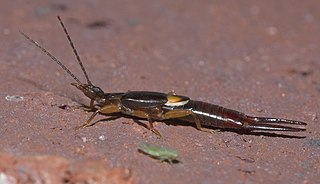
Vostox is a genus of earwigs in the family Spongiphoridae, found in the Americas. There are more than 20 described species in Vostox.

Neodermaptera, sometimes called Catadermaptera, is a suborder of earwigs in the order Dermaptera. There are more than 2,000 described species in Neodermaptera.
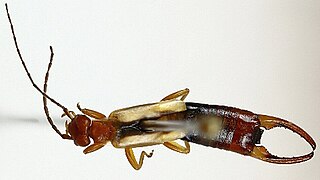
Diaperasticus is a genus of earwigs in the family Forficulidae. There are about six described species in Diaperasticus.










